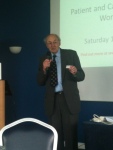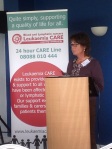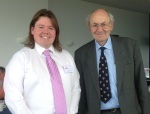On a normal Saturday morning I’d be getting up early with my little boy, Luca, and waiting for him to calm down (normally takes 4-5 hours) watching football and taking it easy. It’s an honour to change that routine this weekend and at 9am I am sat in a conference in Belgrade, Serbia with over 200 delegates; patients and families, clinicians and representatives from organisations who all have a vested interest in Chronic Myeloid Leukaemia (CML).
Our first session covered CML in real life – comorbidities and drug interaction. An outstanding review from Dr Neil Shah provided an overview of age and side effects. It was fascinating to hear the prescriptive differences that come with different age groups, essentially trying to balance tolerance and side effects. There is obviously a strong call for proper management of risks and benefits. I was also interested in the ease at which Dr Shah would move from one treatment to another, clearly not a problem when drugs are available and paid for. But, very much, the perfect scenario.
CML Horizons does a brilliant job in balancing the sessions and Professor Andrija Bogdanovic presented a localised example, from Serbia, of the situation he works in. It’s interesting to see him working with older drugs including hydroxyurea and achieving spectacular results, 78.6% complete cytogenetic response rate after 12 months! His frustrations were clear when talking about the limitations he faced when trying to fund care, “put the pressure on insurance”. Andrija works in a situation very different to Neil Shah but both remain committed, flexible and dedicated to saving lives with the resources they have in hand.
It’s critical to understand how individual our bodies are and how much what we eat affects our drug intake. Dr Annette Freidbank’s session on drug interactions provided a very specific journey into the many ways drug effectiveness can be changed. For example food increasing the effectiveness of nilotinib (Tasigna) by 82%
Once again we heard the warnings about grapefruit affecting the effectiveness of TKIs and we were all very thankful it wasn’t served at breakfast. Natural and herbal products may also cause interactions, it’s a key responsibility to be safe and informed. Therefore, the relationship we have with our doctor is critical, being able to ask advice, both Doctor and patient working together to make sure that the way the drugs are tolerable and ensure the drugs work. It’s a very topical, useful area of investigation.
After a short break we were treated to a presentation from Dr Martin Godfrey about using social media. Sadly some technical issues cut the presentation short but this approach is vital to patient organisations. Even in the 3 years I’ve been attending CML Horizons I’ve seen the conference grow digitally at an exponential rate. It’s certainly making our world much smaller and easier to connect and navigate, for a rare cancer like Chronic Myeloid Leukaemia this is imperative. Whilst this session was a little dry it did provide an overview, for beginners, as to the practical benefits of using social media.
The issues of trust, access, e-safety and misinformation are very, very real. It’s important that we don’t advocate a one-size-fits-all approach. We’re still finding our feet. I’ve seen some amazing results on Twitter and on Facebook, Nigel Deekes’ CML UK Facebook group in particular. Likewise, I’ve seen some horror stories where people have lost control of stories, access or information. Very sad. But, we mustn’t forget this can happen with any form of media, it’s just that social media is far more immediate…hence the fear factor. Only time and knowledge will overcome this.
The differentiated approach to advocacy strategy from Tamas Bereczky was very enlightening. Placing the expert patient at the heart of strategy and ensuring they work with academics, regulators and industry really works, as long as we can keep them motivated! I particularly enjoyed his approach to policy and scientific work and finding the balance between the two, maintaining credibility and increasing knowledge. Tamas is a skilled board member at the European AIDS Treatment Group (EATG) and they have become very good at advocacy work over a long period of time. There is much we can learn from them. The European HIV Testing Week initiative worked very well and was adopted widely as a community initiative.
The case study of Gilead’s Sofosbuvir, which is a life-saving treatment of HVC, was very relevant to the CML audience. The cost of the drug was restrictive and EATG took on a classic activism role to raise the issue. Perhaps we CML patients are too polite, perhaps we need to change?
Finally Tamas presented a very practical approach to advocacy work, I’d recommend looking his slides up when CML Horizons goes digital shortly after the conference. EATG have also created an advocacy manual on their website – www.eatg.org – which I am looking forward to reading.
On to the session many people were waiting for, a packed room for The New Realities: Generics and Copy Drugs in CML. Yoseph Caraco looked at how we assess generic drugs. If you are unfamiliar with the concept of generics, these are drugs where the patent expires and anyone can manufacture them and release them, typically with a 70-90% cost reduction. A huge cost reduction, surely a benefit? The issue is quality. A colleague described this as a classic song being covered by another artist, sometimes it’s still a great song…sometimes it isn’t so good.
Imatinib has a low penetration rate, around 30%, with CML patients worldwide. This is due to the high cost. We were shown that some generics only showed very slight underperformance compared to the parent drug, however it still presents a risk, I certainly wouldn’t want to be part of the 2% that could lose their response. I find it very concerning that we would switch for price alone. When clinical trials are undertaken and quality assurance is given the reassurance means everything to the patient.
Cheryl-Anne Simoneau from the CML Society of Canada took the baton and presented patients as informed decision makers. Canada has a very proactive generic market as the prices are capped to 18%-20% of branded drug prices. Cheryl advocates patient power, ensuring that PCR results are known, tracked and monitored very closely. It is vital that patients are aware of the prescription they are given and if anything changes they report it immediately – this includes packaging as well as any side-effects, “your CML journey is unique to you”. The society is looking to lead by being an promoting the example of an autonomous, informed, engaged patient.
Andrija Bogdanovic and Qian Jiang, both haematologists, discussed generics from their perspective. A variety of issues: no practical experience, different forms, not enough published data, lots of conflicting data in the media and bad experiences. It was noted that the Serbian solution was to switch all 220 CML patients to generic imatinib (Anzovip). Within 3 months 7 patients lost response, they were placed back on the previous drug and regained response. There was a slightly higher loss of response from newly diagnosed patients, after 12 months, who started on imatinib (Anzovip) (IRIS trail comparison). It’s clear that the Serbian haematologists are monitoring the situation very carefully and their clinical approach to generics is very commendable.
Qian Jiang’s focus was whether bio-equivalence is the same as clinical equivalence. She presented an overview of the situation in China where many generics are being released, a differentiation in provincial funding confused the matter even further. The practical advice followed Cheryl-Anne Simoneau’s patient power, ask questions, risk mitigate, wait for the right moment and clinical evidence before switching. She ended by stating that, “generics should not be recommended to patients without solid evidence of clinical equivalence in spite of bio equivalence”.
There are lots of questions being asked of generic drugs, there is no clear answer on whether they are good or bad. It’s about risk mitigation and from a patient perspective not taking a risk, this is life or death after all. Whilst I understand, I have an issue with this coming down to cost. Without clinical trials, which increase the cost, I fear we won’t get the answer we are looking for. For the patient who has no choice, there are no branded drugs available to them at all, generics present a very real opportunity to cling to life…
After a enjoyable night out with friends, I sit writing this blog, contemplating whether it’s worth giving up family time. Nothing is that important, but sometimes we have to make sacrifices. It’s been a good day and I have plenty to take home with me, there’s still a day left. Sunday is just around the corner.














